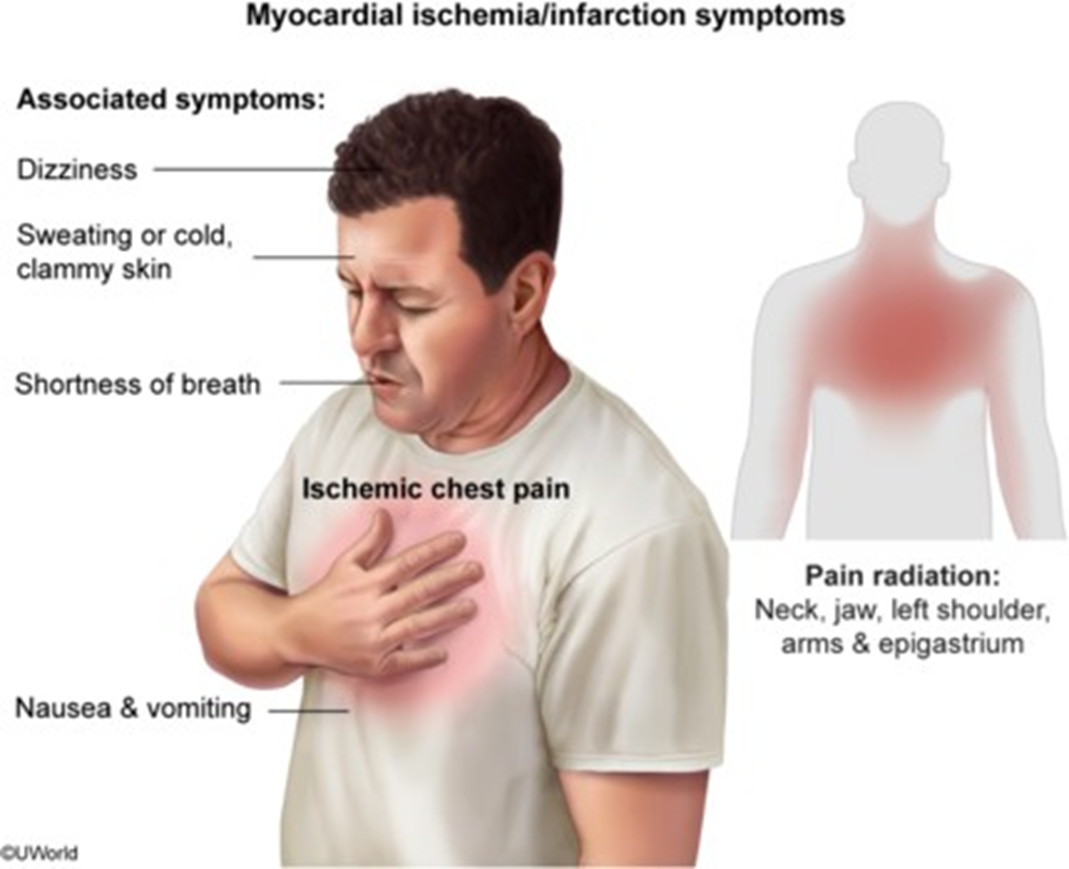A client presents to the emergency department reporting chest pain that is radiating to the left arm, shortness of breath, and diaphoresis. Which medication does the nurse anticipate being prescribed by the healthcare provider?
Morphine.
Oxycodone.
Hydromorphone.
Fentanyl.
The Correct Answer is A
Choice A rationale
The client’s presentation of chest pain radiating to the left arm, shortness of breath, and diaphoresis are classic symptoms of a myocardial infarction (heart attack)56. Morphine is often administered in this situation to relieve pain and reduce the workload of the heart.
Choice B rationale
Oxycodone is a strong opioid medication used to treat severe pain. However, it is not typically the first choice for pain relief in the setting of a suspected heart attack.
Choice C rationale
Hydromorphone is another strong opioid medication used to treat severe pain. Like oxycodone, it is not typically the first choice for pain relief in the setting of a suspected heart attack.
Choice D rationale
Fentanyl is a potent opioid pain reliever. While it can be used in the management of severe pain, it is not typically the first choice for pain relief in the setting of a suspected heart attack.

Nursing Test Bank
Naxlex Comprehensive Predictor Exams
Related Questions
Correct Answer is C
Explanation
Choice A rationale
Keeping the head of the bed elevated until the treatment is completed is not typically recommended to reduce the risk of vesicant extravasation during intravenous chemotherapy.
Choice B rationale
Instructing the client to drink plenty of fluids during the treatment does not directly reduce the risk of vesicant extravasation. Hydration can help maintain good vein health, but it does not prevent extravasation.
Choice C rationale
Monitoring the client’s intravenous site hourly during the treatment is a key action to reduce the risk of vesicant extravasation. Regular monitoring allows for early detection of any signs of extravasation, such as swelling or redness at the IV site.
Choice D rationale
Administering an antiemetic before starting the chemotherapy can help manage side effects such as nausea and vomiting, but it does not reduce the risk of vesicant extravasation.
Correct Answer is C
Explanation
C. Prepare ice packs for placement in the patient’s axillary area.This response is crucial because the symptoms described—muscle rigidity and hyperthermia—are indicative ofmalignant hyperthermia, a serious reaction that can occur after the administration of succinylcholine, especially in conjunction with certain anesthetics. Immediate cooling measures, such as applying ice packs, are essential to help reduce the patient's elevated body temperature.
Rationale for Other Options:
- A. Call the PACU nurse to prepare for prolonged ventilatory support.: While preparing for ventilatory support may be necessary later, immediate action to address hyperthermia is critical.
- B. Hold a prescription for dantrolene until the fever is reduced.: Dantrolene is the antidote for malignant hyperthermia and should be administered as soon as possible rather than held.
- D. Determine if prescribed antibiotics were administered preoperatively.: This action is not relevant to the immediate management of malignant hyperthermia.
Whether you are a student looking to ace your exams or a practicing nurse seeking to enhance your expertise , our nursing education contents will empower you with the confidence and competence to make a difference in the lives of patients and become a respected leader in the healthcare field.
Visit Naxlex, invest in your future and unlock endless possibilities with our unparalleled nursing education contents today
Report Wrong Answer on the Current Question
Do you disagree with the answer? If yes, what is your expected answer? Explain.
Kindly be descriptive with the issue you are facing.
